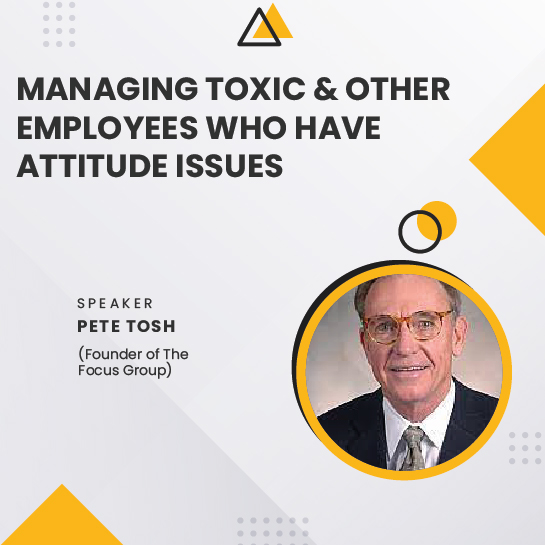Managing Toxic & Other Employees Who Have Attitude Issues
Most organizations have employees who on occasion:
- Complain & gossip excessively
- Use inappropriate language
- Are mildly insubordinate
But Toxic Employees have interpersonal styles that demonstrate a pattern of counter-productive work behaviors. While Emotionally Intelligent employees are aware of their feelings &those of others exhibit a pattern of appropriate self-management.The toxic employee problem is surprisingly prevalent with research showing:
• 95% of employees have &64% are currently working with a toxic employee
• 50% of employees have thought of quitting & 12% did because of a toxic employee
• 25% of employees have reduced their work effort due to a toxic employee
• 20% of employees feel they are a target weekly & 10% of employees see toxic behavior daily
Toxic employees cause significant overt, covert, people-related &financial damage with their visible behavior just being the tip of the iceberg. For example, in one organization the day a former employee leaves the organization is considered one of their annual holidays.
Session Highlights:
I. Human & Financial Costs Resulting from Toxic Employees
- Toxic Employees Create:
- Chaos & unnecessary complexity
- Overt damage
- Covert damage
- Strife, stress & emotional damage
- Productivity, quality & financial losses
II. The A, B, and C’s Related to Toxic Employees
- Employee attitudes
- Employee behaviors
- Consequences that managers can exert
III. The Psyche of a Toxic Employee
- Frequently seen toxic behaviors
- Utilize ‘star status’ & technical expertise to intimidate & manipulate
- A chameleon who knows who to flatter & who he/she can abuse Turn their toxicity on & off depending on the impression they want to make
- Three common forms of toxic behavior
IV. Common Reactions to Toxic Employees that frequently Don’t Work
- Restructuring his/her job to accommodate the toxic employee
- Tolerating toxic employees who bring rare expertise or experience
- Not assertively seeking feedback from employees as to whether there is toxic behavior in the workplace
- Not communicating to all employees, the specific behaviors that will not be tolerated – with associated consequences
V. Effective Approaches for Addressing & Preventing Toxicity Organization-wide strategies:
- Making positive interpersonal behavior organizational value
- Evaluating interpersonal behavior as a part of the performance appraisal system
- Training leaders on how to address toxic behavior
- Using behavioral-based interview questions to screen toxic applicants
- Exit interviewing to identify any toxic behavior in the workplace
Departmental &team strategies:
- Defining appropriate interpersonal interactions with behavior-specific descriptions & standards
- Using team discussions & role play to clarify the application of the behavioral descriptions & standards
- Utilizing a 360-degree feedback process to assess the work environment
One-on-one strategies:
- Stating explicitly that the behavior is not acceptable& why
- Describing both the unacceptable & acceptable behavior
- Asking the employee to commit to & describe how he/she will change his/her behavior
- Frequent, targeted counselling feedback
- Executive coaches
- Progressive discipline
- Termination
But even terminations are not a cure-all because the:
- Toxic-enabling people & organizational culture tendencies may remain
- Employees may still be resentful of the way they were treated by the employee & the time it took the organization to react
- The expertise & experience of the toxic employee are lost
Why you should attend:
Clever toxic employees:
- Utilize their technical expertise to intimidate & manipulate
- Know who to flatter & who they can abuse
- Turn their toxicity on & off depending on the impression they want to make
Unfortunately, organizations can work against themselves & even promote toxicity by:
- Restructuring his/her job to accommodate a toxic employee
- Tolerating toxic employees who have valued expertise
- Not assertively seeking employee feedback as to whether there is toxic behavior in the workplace
- Not communicating to all employees the specific interpersonal behaviors that will not be tolerated – with the associated consequences.
Managers sometimes attempt to fix this type of problem by addressing a toxic employee’s attitude. And while a toxic employee’s attitude certainly affects his/her behavior, managers usually find that controlling an employee’s attitude is next to impossible.
Managers can be much more effective by:
- Discussing the specific behaviors that are negatively impacting other employees and the organization
- Using positive & negative consequences to influence that behavior
Who should attend:
- Anyone with managerial or leadership responsibility
Speaker
Pete Tosh is the Founder of The Focus Group, a management consulting and training firm that assists organizations in sustaining profitable growth.
Prior to founding his own firm 25 years ago, Pete had 15 years of experience — at the divisional and corporate levels — in Human Resource and Quality functions. Pete held leadership positions — including the V.P. of Human Resources and Quality — with Allied Signal, Imperial Chemical Industries, Reynolds Metals, Charter Medical, and Access Integrated Networks.
Recorded Webinar: All Time Available
Duration: 75 minutes
Speaker: Pete Tosh
Related products
-
 Recorded Webinar
Recorded WebinarSexual Orientation & Transgender ID Discrimination In the Workplace: Employer Obligations & Proactive Practices
$0.00 -
 Recorded Webinar
Recorded WebinarPayroll Rules & Administration Simplified Included Review & Implementation of New DOL Overtime Rules
$0.00 -
 Recorded Webinar
Recorded WebinarGarnishment Update 2022
$0.00 -
 Recorded Webinar
Recorded WebinarTravel Pay: Handling it Correctly for 2022
$0.00
More Info:
Connect
Quick Links
Sign up
Promotions, new products, and sales. Directly to your inbox.


Reviews
There are no reviews yet.